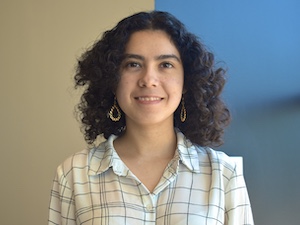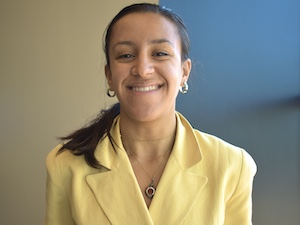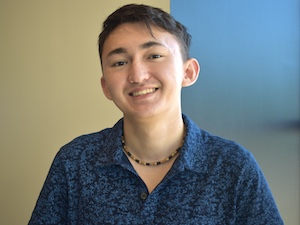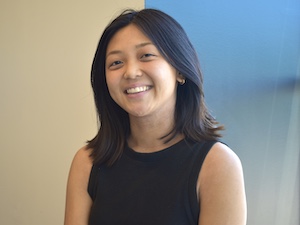2022 Week 2: Arts
 Liesel Arauz Vallecillo | Art With A Heart
Liesel Arauz Vallecillo | Art With A Heart
I think a challenge I was facing this week was adjusting to the workplace environment and how it contrasted with the work that I was doing. When I first had my interview with Art with a Heart to see if I’d be a good fit, I was told that I would be teaching workshops or helping with classes, doing art and installations, and spending most of my time working with creative materials to some degree. I have done this, more or less! The workshops will start in summer, so I’ll get a chance to help with that later. But so far in my internship, most of my days have actually been spent in front of a computer away from the rest of the volunteers and interns. It was a little hard in the beginning just because I felt like everyone was getting to know each other or already did. I felt like I couldn’t really even try since I was the only person aside from the managers who was alone in an entirely different part of the office most of the day on their computer. It was funny in a way since my task to do inventory was so vastly different when I first mentioned it to others, they asked me if I wasn’t certain that it was a fake task to keep me from messing up any mosaics. Although it was a joke, with my lack of experience it wasn’t so far-fetched of an idea. Obviously now, I feel a lot more confident within my placement. I think it was just the shock that day of not really knowing what I was doing and how it was contributing to their mission statement. It’s just that all the interns at that point were being assigned long-term artistic projects that complemented their career or college major goals and on that first day I hadn’t. Now I’m proud to say that my long-term project is setting up the HeARTwares store! I’m really excited for the opportunity to learn more coding and make it a personal project to learn how to automate their SKU number system. I also have taken an interest in administration so I’m excited to work more with my supervisors and learn from them about how a nonprofit is run.
 Lubna Azmi | Wide Angle Youth Media
Lubna Azmi | Wide Angle Youth Media
I had a really packed and exciting week for week 2. Part of what my supervisor is working on is a documentary with a group of Baltimore students. They call themselves the Youth Food Security Network. The film is detailing food insecurity, nutrition, and how it exists as a youth issue in Baltimore city. We filmed our first day this past Tuesday in a studio downtown, and filmed our second day this past Friday at an urban farm called Backyard base camp. I got to know the students who are putting this together, and get to know more people doing food justice work in Baltimore city which was so expansive to engage with.
I also had an event today for work, it was a ceremony for all the apprentices that worked for wide angle this year. They presented their works: films, documentaries, graphic design. I was having a conversation with two of the apprentices, Chamia and Lacee, and they’re both my age. We were talking about our school experiences, Lacee goes to university of Baltimore while Chamia goes to Coppin State. They asked me about Hopkins, and Chamia told me about how she wouldn’t ever want to go to Hopkins because of the connotation it has in Baltimore city. She told me about how her grandmother avoids the area, because she believes Hopkins could snatch her off the street. It’s something I’ve heard many times before, but always in settings where I’m learning about Hopkins’ impact in the city. It hasn’t ever come up in conversation naturally, so it took me aback. She away saying how a lot of Hopkins people don’t know about these issues, and I responded by telling her that she’s all safe to talk about Hopkins however with me, because the relationship between the school and the city is something I am at the very least, decently aware about, although that doesn’t apply to most of the Hopkins student body.
Caroline Colvin | Chesapeake Shakespeare Company
This week was quite research-oriented!
Building off of spreadsheets I created last week, I was able to do a deep dive into Chesapeake’s peer theatre-making institutions. My focus was on understanding the accessibility of live Shakespeare performance: who can and – perhaps more importantly – can’t see these productions, and what ways are American theaters working to make the arts less elitist?
As I mentioned in my blog last week, Chesapeake Shakespeare Company offers free youth tickets to those age 18 and younger; however, this was one of the only classic theaters I came across prioritizing youth arts access. Many theaters DID offer a young professional rate for those 30 and younger, but ticket rates were generally 30-50 dollars – a rate that would not be reasonable for a child’s admission. Other theaters offered ‘local rush’ tickets, extremely reduced ticket rates (50-60% off) for those who lived or worked in the areas nearest these respective theater companies.
While I appreciate that arts accessibility seems to be generally prioritized within classical theatres, I was disappointed in the apparent lack of nationwide youth engagement efforts. Works of art exist largely to reflect the human experience, perhaps – in my albeit biased opinion – best through live theatrical performance. Live storytelling allows us, the audience, to see ourselves reflected in powerful and sometimes unexpected ways. Especially during the tumultuous, confusing years of adolescence (e.g., who am I, where do I belong, what is my relation to the world around me), theatre offers youth the opportunity to reflect inward and connect with a larger human truth (a collective ‘we’). At the most basic level, theatre teaches us that we are not alone in our experiences. It also teaches us valuable skills in empathy, viewing the world through a narrative lens other than our own.
I was privileged to benefit from arts exposure at a young age and credit it to many of my strengths as an adult. In raising the next generation of leaders, we must not forget the vital role of arts in education.
 Christian Paulisich | DewMore
Christian Paulisich | DewMore
The past couple weeks for me have been virtual, which has been convenient but also has prevented me from developing a strong routine. I have learned that scheduling in the non-profit sector is very loose because of the size of the organization and the unpredictability of meetings/tasks/etc. that come up every day. I have learned that the best way to manage this is to communicate. Luckily, my supervisors are very responsive when I communicate that I am unsure about something. I have learned that it is my responsibility to speak up more and communicate my needs/curiosities, which has helped and will help me in my professional and personal life beyond CIIP. I am greatly looking forward to doing more in-person work and developing a stronger work routine in the coming days of this program.
 Jocelyn Shan | Baltimore Youth Arts
Jocelyn Shan | Baltimore Youth Arts
This week was filled with learning. Leisha was out of town this week, so I had fewer meetings and check-ins than normal. While she was away, she left me with several tasks to do, including resource videos that she strongly encouraged me to watch. Looking back, I’m really grateful that she put these resources on my to-do list and insisted that I look into the topics she sent me. She gave me video resources from Mentor Maryland about combatting saviorism in mentorship, Restorative Response Baltimore, and papers on the adultification of Black girls. At first glance, I mentally put these tasks on the back burner and told myself I’d get to them after all the paper work and research and data entering was done. But as I looked at each website and video, I realized how vital this learning was for me. This information is important for me to function in society, but specifically it is important to equip me to connect with the young people in the YouthWorks program starting in July. She shared resources on a lot of topics that I knew about but never delved deep into. So while at work this week I had fewer interactions with my team, I spent a lot of time reflecting and learning.
